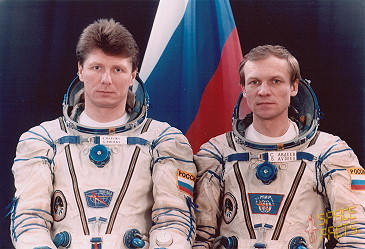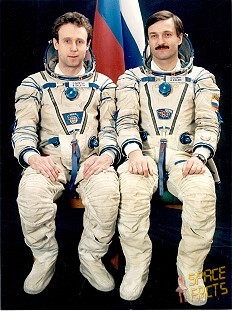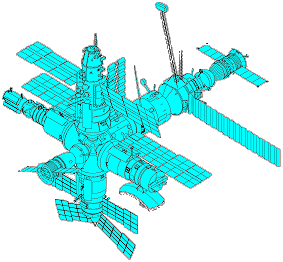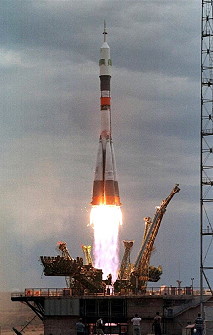Resident Crews of the Mir
![]()
Mir: Expedition 26 |
 |
 |
|
![]()
Crew, launch- and landing data
| No. | Nation | Surname | Given names | Position | Spacecraft (launch) |
Launch date |
Launch time |
Spacecraft (landing) |
Landing date |
Landing time |
Mission duration |
Orbits |
| 1 | Padalka | Gennadi Ivanovich | Commander | Soyuz TM-28 | 13.08.1998 | 09:43:10.871 UTC | Soyuz TM-28 | 28.02.1999 | 02:14:20 UTC | 198d 16h 31m 10s | 3144 | |
| 2 | Avdeyev | Sergei Vasiliyevich | Flight Engineer | Soyuz TM-28 | 13.08.1998 | 09:43:10.871 UTC | Soyuz TM-29 | 28.08.1999 | 00:34:20 UTC | 379d 14h 51m 10s | 6007 |
Backup Crew
| No. | Nation | Surname | Given names | Position |
| 1 | Zalyotin | Sergei Viktorovich | Commander | |
| 2 | Kaleri | Aleksandr Yuriyevich | Flight Engineer |
 |
Expedition Report
|
Launch from the Baikonur Cosmodrome; landing
of Gennadi
Padalka and Ivan
Bella (launched with
Soyuz TM-29)
59 km of Arkalyk. The transport ship Soyuz TM-28 with on-board the crew for the 26th Main Expedition to Mir was launched from Baikonur on August 13, 1998 at 09:43:11 UTC. The crew consists of Gennadi Padalka and Sergei Avdeyev. Also on-board is the politician Yuri Baturin who made a spaceflight of 12 days. To free the docking port for the arrival of Soyuz TM-28 the freighter Progress M-39 separated from Mir on August 12, 1998 at 09:28:55 UTC. The autonomous flight of Progress M-39 lasted until August 29, 1998 when Progress M-39 had to redock to the then again available docking port. Soyuz TM-28 docked at Mir's aft (+X-axis) docking port on August 15, 1998 at 10:56:52 UTC. The intention was to perform approach and docking in the automatic mode with the system Kurs, but at the distance of about 20 meters, when the approach speed was almost 0 m/sec, TsUP seemed to be unsure about the good functioning of the Kurs system and ordered Gennadi Padalka to take over the approach manually. From the distance of 12 meters Gennadi Padalka flawlessly steered his ship to the docking port and accomplished a perfect docking. Well done for a cosmonaut who makes his first spaceflight. He certainly deserved the so called 'manual docking bonus'. Soyuz TM-27 with on-board the relieved Mir-25 crew and the politician Yuri Baturin undocked from Mir on August 25, 1998 at 02:05 UTC and after a short autonomous flight the landing capsule (SA) made a safe landing in Kazakhstan at 05:24 UTC. The flight and the descent took place without problems. Progress M-39 linked up with the aft docking port of Mir on September 01, 1998 at 05:34:58 UTC. Approach and docking were executed in the automatic mode with the system Kurs. Gennadi Padalka reported distances and approach speeds and that he had seen how the engines of Progress M-39 worked. Sergei Avdeyev observed the approach through a porthole. TsUP ordered the cosmonauts to be alert to evacuate if this in case of an emergency was necessary. If he would give this order they had to leave immediately without doing anything. He assured the crew that the approach process was proceeding normally. The cosmonauts had checked the airseal. All was normal. TsUP asked how the quality of the atmosphere inside the Progress M-39 was. Gennadi Padalka said that they had no remarks about that. After the return of the freighter Progress M-39, the cosmonauts were able to execute a number of experiments. From September 01, 1998 until September 03, 1998 they worked on geophysical, astrophysical and medical experiments. During the geophysical experiments they used the lidar Alisa. Apart from medical experiments the cosmonauts also underwent routine check-ups of their cardiovascular system. Gennadi Padalka and Sergei Avdeyev performed an EVA, in fact an IVA, on September 15, 1998 (30m) into the module Spektr. They reconnected some cables for the solar panel steering mechanism. The task during the EVA was relatively easy. The cosmonauts had to connect a few cables to an interface for the steering of solar battery number 3 of Spektr. However, the work was not limited to these 30 minutes for an EVA requires a lot of preparations. For instance, the crew had to prepare the transport ship Soyuz TM-28 for an eventual emergency departure. And after the EVA the Soyuz TM-28 had to be conserved again. The cosmonauts executed astrophysical and geophysical experiments. They used the Mariya spectrometer in the Module Kvant1 to study the generation of high energetic particles in space and the in radiation belts around the earth. Medical check-ups and experiments revealed that the health and physical condition of the crew is excellent. During a private conversation Sergei Avdeyev said that he expects to return to earth towards the summer of 1999. TsUP and the crew regularly discussed problems regarding the oxygen production for Mir's mini atmosphere. Every day the cosmonauts were engaged in the functioning of the Elektron oxygen generators. These systems did not fail, but it was clear that the crew did not trust the automatic functioning of them, and took over manually at every given moment. On October 10, 1998 TsUP spoke about the possibility that the CO2 amount in Mir's atmosphere was too high. Telemetry gave a value of 5.9. Gennadi Padalka said that nothing was wrong and that they still felt excellent. Sergei Avdeyev checked the Vozdukh CO2 filter and did not find anomalies. Later the value had been increased to 6.0 and the crew took counter measures by using ventilators to blow the air through the whole complex. This did not help. To decrease the CO2 amount the crew got orders to adjust the Vozdukh scrubber in the Base Block. Progress M-40 blasted off from Baikonur on October 25, 1998 at 04:14:57 UTC. Besides the normal supplies (food, water, fuel, post, hard- and software, repair material) Progress M-40 had on board experiments for the French- and Slovak expedition in February or March 1999. The Progress M-40 also delivered at Mir the experiment Znamya 2.5, a reflector which will have to give some areas on Earth the impression that they got a new 'moon'. The experiment could be executed after the undocking of Progress M-40 when the Russians are sure that the last freighter to Mir (Progress M-41) is well underway so certainly not earlier than February 1999. The Znamya-2.5 solar illumination experiment was a follow-on to the earlier Znamya-2 experiment on Progress M-15 in 1992. The 25 m diameter Znamya reflector, which would unfold from the nose of the Progress, was to reflect sunlight over a 6 km area onto selected cities. Znamya-2.5 was developed by the Space Regatta Consortium, led by RKK Energiya. Energiya had long studied such space mirrors as a means of providing lighting to Siberian towns. The project was opposed by environmentalists and astronomers, who feared light pollution. The freighter docked with the rear (+X, Kvant) docking port of the Mir station on October 27, 1998 at 05:43:42 UTC. Approach and docking were executed in the automatic mode with the system Kurs. Progress M-40 undocked on February 04, 1999 at 09:59 UTC, but the attempted deployment of the Znamya-2.5 reflector was thwarted when it snagged on a rendezvous system antenna. After two more failed attempts to deploy the antenna the experiment was abandoned. Progress M-40 fired its engines at 10:16 UTC on February 05, 1999, braked out of orbit, and burned up over the Pacific Ocean. Progress M-39 undocked from Mir on October 25, 1998 at 23:03:24 UTC. Indeed, the Russians maneuvered a lot with this ship after the undocking. The ship flawlessly responded on steering commands and the crew made video-images and measurements with spectrometers. On October 29, 1998 at about 06:30 UTC deorbit impulses was given for burning up over a designated area in the Pacific East of New Zealand. The second EVA occurred on November 11, 1998 (5h, 54m). The cosmonauts installed a meteoroid detector in for the upcoming Leonid shower, and hand-launched the Spoutnik-41 amateur-radio mini satellite. During this EVA the cosmonauts had to accomplish 17 tasks: the launch of the mini-sputnik Spoutnik-41, (which they immediately did when they entered open space) the instalment of a number of experiments and the retrieval of mainly Russian experiments. Among the installed experiments was a French one, a so called 'meteorite trap' to catch fragments which are expected to pass in a few days. These will come from the dust cloud behind the comet Tempel-Tuttle. The name of the meteorite rain is Leonids. During the Leonids (the dust cloud behind the comet Tempel-Tuttle) in the period around November 17, 1998 the cosmonauts were hide in the Soyuz TM-28 during periods in which this might be dangerous. The highest intensity was expected on November 17, 1998 at 19:43 UTC. In the Soyuz TM-28 the cosmonauts are protected against the incoming fragments by the whole axial length of the complex (the Base Block, the module Kvant1 and the Progress M-40). They also had the radial positioned modules Kvant2, Kristall, Priroda and Spektr as extra umbrellas. In December 1998 the crew executed a lot of experiments and most of their working hours were used for these activities. Less time was spent on maintenance and repair work of the life systems, for instance they refueled the hydraulic thermoregulation system of the Kvant2 module. They also had to repair electronic parts of experimental equipment (power units, interfaces, cables a.s.o.). Among the executed experiments was the study of plant growth in the greenhouse Svet, the determination of optical characteristics of the earth's atmosphere with the photometer EFO-2, and with the magnetic spectrometer Mariya the study of high energetic particles in space and in the radiation belts of the earth. Regularly the furnaces Krater, Gallar and Optizon passed in review. The cosmonauts also had to undergo medical checks while training on the home trainer (velo-ergometer) and the treadmill. In January 1999 they paid attention to a number of well-known experiments such as: the French Fiziolab (medical), Ionozond (sensing the ionosphere in the benefit of the ionospheric stations in Narafominsk and Rostov), the Greenhouse, Portapress (blood circulation), Relaksatsiya (the study of the influence on molecules of products of combustion for which now and then small impulses of the engines were needed), Silay (the study of small particles from outer space resulting in minor flashes in the eyes of the cosmonauts), etc. Apart from these and their experiments they had to do maintenance work, for instance the replacement of a ventilator of the Gas Analyser, mending the system for the transfer of urine, the installation and dismounting of experimental equipment and the separation of water in one of the Elektron oxygen generators. They also now and then checked the pressure in the Spektr module. Another regular reported measurement was the radiation level on board. This was always done by Sergei Avdeyev who used the Doza system. The values (doses) were given in ug-s and the velocities in mg-s per hour. On February 08, 1999, at 11:23 UTC Gennadi Padalka and Sergei Avdeyev undocked from Mir's -X port in Soyuz TM-28, and redocked at the +X Kvant port at 11:39 UTC, freeing up the front port for the Soyuz TM-29 docking. Sergei Avdeyev remained on Mir with the Mir-27 crew delivered on Soyuz TM-29, heading for a manned space flight time record. Soyuz TM-29 docked with Mir on February 22, 1999 at 05:36 UTC. Since two crew seats had been sold (to Slovakia and France), Viktor Afanasiyev was the only Russian cosmonaut aboard. This meant that Russian Flight Engineer Sergei Avdeyev already aboard Mir would have to accept a double-length assignment. The Soyuz spacecraft is composed of three elements attached end-to-end - the Orbital Module, the Descent Module and the Instrumentation/Propulsion Module. The crew occupied the central element, the Descent Module. The other two modules are jettisoned prior to re-entry. They burn up in the atmosphere, so only the Descent Module returned to Earth. Having shed two-thirds of its mass, the Soyuz reached Entry Interface - a point 400,000 feet (121.9 kilometers) above the Earth, where friction due to the thickening atmosphere began to heat its outer surfaces. With only 23 minutes left before it lands on the grassy plains of central Asia, attention in the module turned to slowing its rate of descent. Eight minutes later, the spacecraft was streaking through the sky at a rate of 755 feet (230 meters) per second. Before it touched down, its speed slowed to only 5 feet (1.5 meter) per second, and it lands at an even lower speed than that. Several onboard features ensure that the vehicle and crew land safely and in relative comfort. Four parachutes, deployed 15 minutes before landing, dramatically slowed the vehicle's rate of descent. Two pilot parachutes were the first to be released, and a drogue chute attached to the second one followed immediately after. The drogue, measuring 24 square meters (258 square feet) in area, slowed the rate of descent from 755 feet (230 meters) per second to 262 feet (80 meters) per second. The main parachute was the last to emerge. It is the largest chute, with a surface area of 10,764 square feet (1,000 square meters). Its harnesses shifted the vehicle's attitude to a 30-degree angle relative to the ground, dissipating heat, and then shifted it again to a straight vertical descent prior to landing. The main chute slowed the Soyuz to a descent rate of only 24 feet (7.3 meters) per second, which is still too fast for a comfortable landing. One second before touchdown, two sets of three small engines on the bottom of the vehicle fired, slowing the vehicle to soften the landing. Finally, on February 27, 1999 Mir-26 Commander Gennadi Padalka and Slovak cosmonaut Ivan Bella undocked Soyuz TM-28 from the Kvant rear docking port at 22:52 UTC, landing in Kazakhstan on February 28, 1999 at 02:14:20 UTC. The new Mir-27 crew consisted of Viktor Afanasiyev as Commander, Sergei Avdeyev as Flight Engineer and French cosmonaut Jean-Pierre Haigneré. |
EVA data
| Name | Start | End | Duration | Mission | Airlock | Suit | |
| IVA | Padalka, Gennadi | 15.09.1998, 20:00 UTC | 15.09.1998, 20:30 UTC | 0h 30m | Soyuz TM-28 | Mir - Spektr | Orlan-M No. 4 |
| IVA | Avdeyev, Sergei | 15.09.1998, 20:00 UTC | 15.09.1998, 20:30 UTC | 0h 30m | Soyuz TM-28 | Mir - Spektr | Orlan-M No. 6 |
| EVA | Avdeyev, Sergei | 10.11.1998, 19:24 UTC | 11.11.1998, 01:18 UTC | 5h, 54m | Soyuz TM-28 | Mir - Kvant2 | Orlan-M No. 5 |
| EVA | Padalka, Gennadi | 10.11.1998, 19:24 UTC | 11.11.1998, 01:18 UTC | 5h, 54m | Soyuz TM-28 | Mir - Kvant2 | Orlan-M No. 4 |
Relocations of Manned Spacecrafts
| Spacecraft | from | Undocking | Time UTC | to | Redocking | Time UTC |
| Soyuz TM-28 | Mir - Kvant | 27.08.1998 | 05:47:00 | Mir - Baseblock | 27.08.1998 | 06:07:09 |
| Soyuz TM-28 | Mir - Baseblock | 08.02.1999 | 11:23:04 | Mir - Kvant | 08.02.1999 | 11:39:07 |
Photos / Graphics
 |
 |
 |
| © |  |
Last update on May 10, 2020.  |
 |